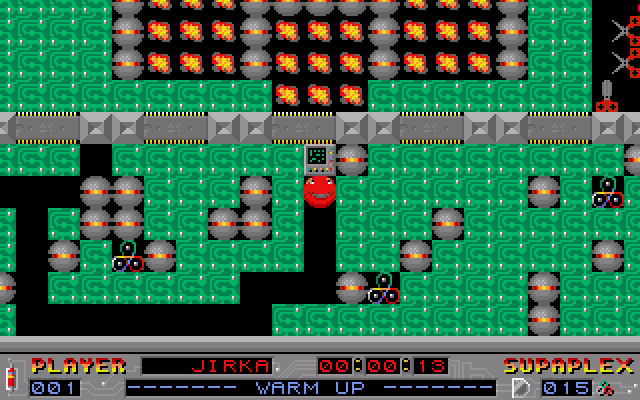After we selected the best games from 2001 to 2010 (the first was Half-Life 2), I decided to remember the gaming classics - the games of the previous 10 years (1991-2000).
The 90s of the last century were truly a “golden time”. If computer games were born in the 80s, then the 90s became a heyday, in these 10 years the foundations of all modern games were laid, and I (apparently as a representative of the 80s generation) believe that in those times there were much more interesting games than now.

A huge nostalgic post and at the very end a vote for the best game.
Also, if you were into gaming at the time, make sure you have some free time, the post might get long :) So, let's go!
I started playing back in Soviet times, so I managed to catch the hits of the 80s: Galaxian, Pac-Man, Frogger, Digger, Lode Runner, Saboteur, Arkanoid, Tetris. And in the 90s, games reached a new level. So, the games are in release order (approximately), we will only talk about PC games.
Commander Keen and Dangerous Dave series

The famous company id Software began its journey with these game series. You don’t even have to try the first three parts of Commander Keen, they’re too “antediluvian.” But 4, 5 and 6 (all released in 1991) are still quite suitable. Keen is a space boy who fights with alien monsters, passing level after level. The final goals are different - in the 5th part, for example, you need to save the galaxy, and in the 6th part you need to save your own nanny! :)
Of course, the plot here is secondary - this is a classic arcade game, in which the most interesting thing is to run, jump, shoot and collect bonuses, and also look for secrets on the levels. By the way, the game has a built-in mini-game similar to ping pong, remember? :) I also remember an evil, huge monster that couldn’t be killed, but as soon as it heard you, it started firing from its space machine gun :)
The Dangerous Dave series was similar, the first part in 1990 was not too interesting, something like an advanced Lode Runner. The second part - Dangerous Dave in the Haunted Mansion (1991) - made the series famous (remember Babok Hezhek throwing knives?), and in 1993 two more parts were released in the same spirit.
The Lost Vikings (1992)

Another arcade game from another great company, Blizzard Entertainment (which was then called Silicon & Synapse). There is not one main character, but three - three Vikings were abducted by aliens - now they have to find their way home, passing 37 levels, quite diverse.
The great idea of this game is that each Viking has his own unique abilities - one runs fast and jumps high, the second slashes with a sword and shoots with a bow, the third has a shield - and the player will have to use these skills individually and in combination to win enemies and solve all the puzzles. In 1996, the second part was released, but it was much worse (and was made by a different company). By the way, in 1994, Blizzard made another good arcade game - BlackThorne.
Lemmings Series

The first part was published in 1991. There weren't many games back then, so Lemmings was fascinating. We can say that this is a logical arcade game: in order to complete the next level, it was necessary to guide these non-existent animals to the exit in a limited time, using their various abilities - among them were diggers, blockers (they didn’t let others go where they shouldn’t), suicides (exploded) and a host of others.
A lot of sequels were released, 3D Lemmings was released in 1995, but, as in many cases with other games, transferring to 3D was a bad idea, and in 2000 Lemmings Revolution was released, returning fans of the series to the familiar form.
The creators of the eternal hit Worms were probably inspired by this particular game, they simply made the worms fight with each other, and not look for a way to exit the level.
Civilization (1991) and Civilization II (1996)

During the first Civilization, games were carried on 3- and 5-inch floppy disks, with several games sometimes being placed on a floppy disk. Civilization introduced us to the world of turn-based strategies and spawned a number of similar games, many of them associated with the name of Civilization author Sid Meier.
In Civilization, we were the creators of history, actually acting in the role of God: we built cities, chose how to develop (reinvent the wheel now or later), monitored the “level of happiness” of the population, made friends and fought with other civilizations (where would we be without this). And before you know it, we have grown from primitive people into a country launching a spaceship to Alpha Centauri.
Civilization V was recently released (read our review), so the series continues to evolve.
Wolfenstein 3-D (1992)

It is from this game id So
ftware began the FPS (first-person shooter) genre, one of the most popular genres to this day (however, back in 1991, the guys from id made the little-known shooters Hovertank 3D and Catacomb 3D).
Wolfenstein is the name of the castle in whose dungeons the Nazis hid the main character (that is, you), the American agent William Blazkovich. Well, you have to get out of the labyrinths of the castle, shooting at the SS, Gestapo, and maybe you will be able to kill Hitler himself! It was still impossible to jump and look up/down, but you could already strafe. Several weapons, first aid kits, secret rooms - many standards were laid down in Wolfenstein 3-D.
The game received a sequel, Spear of Destiny, and more recently Return to Castle Wolfenstein (2001) and Wolfenstein (2009), so this series of games is still alive. Blake Stone (1993) and Corridor 7 (1994) were released on the Wolfenstein 3-D engine.
Gobliiins (1991), Gobliins 2 (1992) and Goblins Quest 3 (1993)

Three episodes of a funny magical quest about goblins delighted us in the early 90s. The number of letters i in the name of the game indicated the number of goblins you control, and each of them has its own characteristics. A rare exception, we were often happy to find the right solution, because the wrong options were accompanied by funny episodes and laughter.
Later, the developers from Coktel Vision released a quest with the tricky name Woodruff and the Schnibble of Azimuth (1994) - if you love Goblins, then play it - the same style and the same humor. More recently, in 2009, Gobliiins 4 was released.
Dune II (1992) and Dune 2000 (1998)

If the first turn-based strategy was Civilization, then the first real-time strategy (RTS - real-time strategy) was this game. The plot was based on the famous book by Frank Herbert; success was also facilitated by the fact that in 1984, a film directed by David Lynch was released based on the book.
The game was a breakthrough, and soon the first Warcraft arrived. Dune II laid the foundations of the genre: base building, resource extraction and, of course, real-time battles. It was the most difficult for the Ordos. Remember the giant sandworms that ate equipment? :) If it were possible to combine troops into groups, then we could try to play now, but moving units one at a time is, to put it mildly, unusual. True, there are mods that correct this flaw. In 1998, a good remake was released - Dune 2000, so if you have nostalgia for Dune, then you can play it.
By the way, there was the first Dune (1992), which few people played, but at the same time it was an interesting game, especially for fans of the book and film, a mixture of quest and strategy.
Mortal Kombat 1-4 (1992, 1993, 1995, 1997)

There are few games, even famous ones, that I can boast that an equally famous film was made based on them. Mortal Kombat is a classic fighting game, the game series developed from the beginning to the end of the 90s, in the fourth part it became three-dimensional, but the second part is considered a classic. Most players of the 90s and now can list all the characters in the game, and their hands still remember the button combinations for their favorite fatalities.
Of course, Mortal Kombat is more of a console game, so it continued its development exclusively on consoles in the 2000s.
Alone in the Dark series

The first part was released back in 1992, which gives it the right to be called the very first horror quest. A journey through a creepy mansion (it was recommended to play at night to heighten the fear) with excellent graphics for those times and atmospheric music. The second and third parts (1993 and 1995) continued traveling through abandoned mystical places and battles with evil spirits. Two more parts were released in 2001 and 2008. In its appearance and arcade elements, the game is similar to Little Big Adventure. It is also worth mentioning two more mystical quests from Infogrames based on Lovecraft’s famous Cthulhu myths - Shadow of the Comet (1993) and Prisoner of Ice (1995).
Comanche Series

The famous helicopter simulator, which has grown from arcade to serious. Already in 1992, we could fly over a wide variety of territories and with different weather conditions, destroying air and ground targets. By the way, the author of the game, Nova Logic, is also the developer of the Delta Force series, and the games are somewhat similar - Delta Force was similar to a soldier simulator.
Games in the Comanche series were released until 2001.
The Legend of Kyrandia (1992, 1993, 1994)

The rivalry between Sierra On-Line and LucasArts was diluted by this trilogy of quests in the magical world. Surprisingly, Westwood Studios managed to create successful games in a variety of genres in the 90s (what a pity that this did not save it from closure
existence). In strategy, these were Dune 2 (and Dune 2000), the Command & Conquer and Red Alert series. In role-playing games, these were the Eye of the Beholder and Lands of Lore series, as well as Nox. Quests include Blade Runner and The Legend of Kyrandia series. There was also an arcade called The Lion King.
If you liked Kyrandia, then you played (or should play) another series - Simon the Sorcerer - the first (1993) and second (1995) parts were released in the 90s, and three more in the 2000s. A fantasy world, an aspiring wizard, and a large dose of humor are all hallmarks of both series.
Doom (1993) and Doom II (1994)

A cult game of all times and peoples. So famous that even those who have never played computer games know about it :) Just a year after Wolfenstein 3-D, id Software released a new first-person shooter (I suspect that the guys, getting carried away, worked for days), which became the “father” for all subsequent shooters. The demonic and even satanic (thank you, John Romero) game, where you shoot all sorts of fiends of hell, has gained enormous popularity.
Jumping was still not possible, but online play was now available! And a level map. When I got a home computer, my first game was, oddly enough, Dark Forces, which came out in 1995 (the second part in 1997), it was the first shooter based on Star Wars. So, there you could already jump, look up/down, and the graphics were better than in Doom, but who remembers Dark Forces now? By the way, this good game was “killed” by the lack of online play and the ability to save at a level.
The words IDDQD and IDKFA forever remained in the memory of fans :) Doom received many official and unofficial sequels and mods, I won’t even list them. For example, I played a mod with several levels that were nothing more than the building of my own university, and the rector was a cyberdemon who had to be killed at the end :)
It is worth mentioning that in 1995 the domestic shooter “Kremlin Dungeons” was released. He was noticeably weaker than his foreign competitors, but he was originally Russian: what are the Baba Yagi worth as monsters or the phrase “A bucket of living water added 10 years of life” :)
Doom is alive and well: Doom 3 was released in 2004, Doom 4 is in development, a movie based on the game was released in 2005, and Doom Resurrection was released for the iPhone in 2009.
Master of Orion (1993) and Master of Magic (1994)

The legacy of Civilization has been extensive and among its many successors, these two excellent games stand out. We were offered alternative worlds compared to “Civilization”: in MoO the action takes place in space, and in MoM it takes place in a fantasy world.
Master of Orion was impressive in its scope - economics, technology, ship design, battles, diplomacy, espionage - all in one game. Subsequently, two more parts of Master of Orion were released (in 1996 and 2003), but they had many changes not for the better, so fans of the series still prefer the first part.
But there was no sequel to Master of Magic, which is a shame, because if you did a remake now with the same gameplay, but with beautiful graphics and sound, the game could compete with Heroes of Might and Magic and Disciples. Thanks to the efforts of Triumph Studios, we finally got the successor to MoM in the form of Age of Wonders (1999) and Age of Wonders II (2002).
Myst (1993) and Riven (1997)

Extraordinarily beautiful graphics for those times and a mystical (one would like to say Myst’ic) exciting plot made this game a cult favorite. With 6 million copies sold (Riven has 4.5 million), Myst is among the best-selling games of all time. The game gave birth to an entire genre - first-person graphic quest - and many games are still awarded the epithet “Myst-like”.
Simultaneously with Myst, another famous game was released - The 7th Guest (1993, 2 million copies sold) - and its sequel The 11th Hour (1995). The 7th Guest was the first game to use video scenes and was the first puzzle horror game. If Myst's successor was Lighthouse (1996), then 7th Guest's successor was Shivers (1995). Also in 1993, Return to Zork was released, a graphical embodiment with a first-person view of the famous series of text quests of the 80s, and in 1996, its continuation, Zork Nemesis, was released. In the Myst genre, Lost Eden (1995) also comes to mind - a beautiful journey through the world of dinosaurs.
Myst spawned not only sequels, remakes and parodies, but even books and comics. Riven continued the work of Myst, and in the 2000s, 3 more sequels were released. In 2000, a three-dimensional remake of the first part, realMyst, was released, and the game was also released on various platforms, including iPhone, PSP, Pocket PC, Nintendo DS.
SimCity (1989), SimCity 2000 (1994) and SimCity 3000 (1999)

This classic series spawned
th genre. And the developer company Maxis itself, in addition to the sequels of the game (still being released), has released a bunch of similar games: SimEarth, SimFarm, SimCopter, SimAnt, SimLife, SimIsle, SimTower, SimPark, SimSafari and others, and finally the apotheosis in the form of The Sims.
Business or life simulators seemed to be the embodiment of the Monopoly board game. I remember Transport Tycoon (1994), Theme Park (1994), Capitalism (1995), Theme Hospital (1997). And the alternative to modern SimCity was the ancient Roman Caesar, and Settlers too.
Simultaneously with the first SimCity, the game Populous was released in 1989, in which the developers decided not to limit themselves to one city, but gave the player control of an entire nation in the ancient world. Populous became the founder of a new genre - “God simulator”, and in the 90s two more parts were released, and in 2001 Black & White was released, which became the successor to the series.
SimCity can serve as a training program for future mayors: after all, you need to rebuild a modern city, with specific goals. Transport, energy, taxes, resistance to force majeure, etc. - all of this needs to be managed.
Arcade 90s
An eternal genre that will be popular for a long time - after all, you don’t always want to play complex games, but now it’s convenient to play an arcade on a phone or portable console. In the early 90s, when games were not yet too complex, there were many arcade games. I already remembered Commander Keen, Dangerous Dave and The Lost Vikings, and now other famous arcade games and their heroes:


— I’ll start right away with two famous heroes - the plumber Mario and Sonic the hedgehog - in general, of course, these are not PC games (although some games of both series were also on PC), but their heroes are so famous that it’s impossible to write about arcades them would be blasphemy :) By the way, the Mario series is listed in the Guinness Book of Records as the best-selling game of all time.

— Prince of Persia (1989), Prince of Persia II (1993), Prince of Persia 3D (1999) - another game that doesn’t need any introduction. The third part was similar to Tomb Raider, and in the 2000s the game series was successfully revived and even made into a film.

- Gods (1991) - a medieval-mystical arcade game from the Bitmap Brothers, who later gave us strategy Z; at that time, Gods had excellent graphics.

- Metal Mutant (1991) - the original was a game with quest elements - we control a transforming robot that could turn into a cyborg, a combat robot or a metal dinosaur.

- Prehistorik (1991) and Prehistorik 2 (1993) - remember this funny primitive guy with a club in search of food? :)

- Ugh! (1992) is also a primitive arcade game, only here you didn’t have to run, jump and hit dinosaurs, but deftly control a wooden helicopter.

— Duke Nukem (1991) and Duke Nukem II (1993) - if you didn’t know, old Duke was an arcade game first, but even then he was a very cool guy :)

— Dizzy series — admit it, girls, have you spent more than one hour playing as this cute and positive egg man? There were no battles or shooting, the game was more like a quest.



- Another World (1991), Flashback (1992) and Fade to Black (1995) - these three games from Delphine Software had quest elements, if the first two are arcade games, then Fade to Black is a third-person shooter (almost not the father of the genre, as it came out before Tomb Raider).

— Aladdin (1993) – arcade game based on the famous Disney cartoon.

- The Lion King (1994) - a journey through the jungle of growing Simba was made by the famous Westwood Studios.

- Jazz Jackrabbit (1994) and Jazz Jackrabbit 2 (1998) - The green bunny was a great alternative to Sonic the Hedgehog.

- Mystic Towers (1994) - an isometric arcade game with a role-playing slant, we walk through the labyrinths of the castle and fight monsters.

— BlackThorne (1994) — Blizzard made not only The Lost Vikings, but also this arcade action game: reminiscent of Prince of Persia, then
only instead of a sword there is a shotgun and grenades.

- Earthworm Jim (1994), Earthworm Jim 2 (1996), Earthworm Jim 3D (1999) - a superhero worm fighting universal evil gained enormous popularity, an animated series was filmed about him and a comic book was made about him. By the way, remember the main character of the Neverhood quest, he looks like Jim the Worm, right? They were both designed by artist Douglas TenNapel.

— Oddworld: Abe’s Oddysee (1997) and Oddworld: Abe’s Exoddus (1998) are very original games that revived the genre, there’s not even anything to compare it with, it’s more of a two-dimensional quest. Or is it still an arcade? In general, if you haven’t had time to play yet, then it’s not too late - fans of both genres should like it.

- Postal (1997) - you can say that this is a third-person shooter, but the gameplay was simple, so we will consider it an isometric arcade game. It was distinguished by the fact that it was banned in many countries (still, the level of violence went off scale, we play as a maniac killer and shoot everyone in a row), and it would have remained a scandalous mid-level game if its cult sequel had not been released in 2003 first person. The film was released in 2007, and all fans are waiting for Postal 3 this year.
Quests from Sierra On-Line

We can say that it was the Sierra company that invented the quest (adventure) as a genre. Escape games were very popular in the 90s, and the main rivalry was between two companies: Sierra vs. LucasArts. And if the second one made a lot of them, then Sierra released a simply mind-boggling number of games in this genre, and it is famous for its series of games.

— King’s Quest (8 parts): adventures of the royal family in a fantasy world. By the way, in the 2000s they made remakes of the first three parts, so you can play them now.

— Space Quest (6 parts): a humorous series about the misadventures of a failed space janitor who often saves the universe by accident :)

— Quest for Glory (5 parts): again a fantasy world, and at the beginning of the game you had to choose a hero class: warrior, thief or mage (reminds me of nothing?). At the same time, in addition to solving quest tasks, the game had battles and a role-playing component.

- Leisure Suit Larry (7 parts in the 90s and 2 more parts in the 2000s) - the adventures of a woman lover Larry, a game with elements of eroticism, the incentive for completing it was often to look for these same elements :)

- Police Quest (4 parts, then the series continued in other genres) - police officers investigate crimes, and former police officers were directly involved in the creation of the game.

— Gabriel Knight (3 parts) — a private detective reveals mystical adventures.

— Gobliiins (3 parts in the 90s, the 4th was released in 2009) — a humorous quest about the adventures of goblins in a fairy-tale world.

— EcoQuest (2 parts) — educational quests for children.

- Phantasmagoria (2 parts) - the famous horror game was released in 1995 on 7 discs (which was unprecedented for those times), a young couple enters a house with a dark past, we play as a girl and try to uncover the secrets of the house - in fact, it was a film , since the characters were not drawn, but filmed - they were played by real actors. The second part (1996) was filmed in a similar way and was released on 5 discs. In the same horror genre, in 1996 the game Ripper was released from the Take-Two Interactive studio (on 6 discs) with Christopher Walken as a guest star.

— Shivers (2 parts) — Myst-like horror game with a set of puzzles. Here we can also mention the game Lighthouse (1996) from the same genre.

— Of the single games without a sequel, it is worth mentioning Torin’s Passage (1995) - a fantasy quest with a young hero in the main role. I also associate with this game the excellently rendered Fable (1996) from the Sir-Tech company.
Role-playing series of the 90s
If the third-person view is now popular in RPGs, then in the first half of the 90s, the first-person view, as in shooters, was generally accepted. Only the Ultima series had a player-side view, and only with the release of Diablo, Fallout and Baldur’s Gate did the trend turn towards isometric RPGs. Let's see
to the most famous role-playing series:

— Ultima (9 parts) — the first 5 parts came out back in the 80s, and 4 more came out in the 90s. Big world, NPCs living their own lives, freedom of action, no clear division into Good and Evil. We can say that this series stood at the origins of the genre (the first part was released in 1981, and its prequel in 1979) and became the parent of the RPG with a third-person view. The series was reborn into the famous Ultima Online, in fact it was the first online RPG, since it some people spent much more time in virtual life than in real life.

— Ultima Underworld (2 parts) — the contribution of the Ultima game series to the role-playing genre can hardly be overestimated. If in other classic series the movement was frame-by-frame, then here it was continuous, like in shooters (by the way, the game was released simultaneously with Wolfenstein 3D), and here you could look up/down!

- Wizardry (8 parts) - 5 parts in the 80s, 2 parts in the 90s and 8 in 2001. A team of several characters with unique characteristics and equipment for each, traveling through labyrinths and killing monsters - these are typical features of role-playing series of that time, and Wizardry as a classic series is no exception.

— Might and Magic (9 parts) - 2 parts in the 80s, 6 parts in the 90s and the 9th in 2002. A large world that grows with the release of each new part, as well as a choice between turn-based combat and real-time combat - that's what comes to mind about Might and Magic. Another famous series is also associated with this world - Heroes of Might and Magic.

— Eye of the Beholder (3 parts) — the first two parts were made by Westwood, the third by SSI (it’s worse). Carefully drawn graphics (a Westwood signature), interesting plot, witty riddles and secrets, difficult battles.

— Lands of Lore (3 parts) — Westwood made this series after Eye of the Beholder, excellent graphics and sound.

- The Elder Scrolls (4 parts) - 2 parts in the 90s, 2 parts in the 2000s. Action RPG with a huge world, which received a sequel in the form of the famous Morrowind and Oblivion.

- Betrayal at Krondor (1993), Betrayal at Antara (1997) and Return to Krondor (1998) - this series left you feeling like you were in a book (and so it was - the game was based on fantasy works) and became one of characters in it, the plot was divided into chapters, the classic first-person view was interspersed with isometric battles.

— Ishar (3 parts) — this not very well-known role-playing series featured excellent graphics.

- Allods (3 parts) - almost the first Russian game to gain worldwide fame. Needless to say, it was nice to play not a localized, but an originally Russian high-quality game, in places using our history and folklore. Now the game has been reborn into “Allods Online”.
Puzzle games of the 90s
To be honest, I haven’t played many games in this genre, but I remember a few.


- Rockford (1988) and Supaplex (1991) are a legacy of the 80s, similar to Digger and Pac-Man, the goal of the game was to collect all the bonuses in the level and not die in the process.


- Chessmaster and Battle Chess series - Chessmaster has been the most popular implementation of chess on a computer since the 80s to the present day, and Battle Chess introduced an element of dynamism - the chess pieces were alive and actually walked and fought on the field.

— Color Lines (1992) - the main competitor of Solitaire Solitaire as a “time killer” for female workers :)

— The Incredible Machine series — it was necessary to connect various mechanisms and devices into a sequential chain, which, when launched, would complete a level task.
Sports games of the 90s

In 1993, the famous football and hockey series from Electronic Arts: FIFA and NHL started. From golf simulators, I remember the Microsoft Golf series, from billiards simulators - Virtual Pool, both started in 1995. I haven’t played much sports games, so if you remember, write in the comments.
Let's get back to the game review.
Wa
rcraft (1994) and Warcraft II (1995)

With these games began the glory of the great Blizzard - a company that makes only hits. If the plot of Dune II unfolded in the world of the future, then Warcraft offered an alternative in the fantasy style. These were the first strategies that laid the foundations of the genre. In the first Warcraft, it was finally possible to unite troops - up to a maximum of 4 units and not with a “frame”, but with the help of the Shift button :)
Warcraft II brought Blizzard to the top - it was an excellent game in all components: nice “cartoon” graphics, beautiful cutscenes, multiplayer, great voice acting, map editor.
It seems that the Blizzard developers worked around the clock after the first Warcraft - to release the second part just a year after the first - it’s hard to imagine how they did it. In Russia, the success of Warcraft II was also facilitated by the excellent translation/voice acting from the SPK (Word Palette Code) studio - perhaps this translation, and the translations of the Full Throttle and Neverhood quests can be called the best localizations of the 90s.
The second part received a sequel - Warcraft II: Beyond the Dark Portal (1996) - it was made by Cyberlore Studios. Warcraft II was so popular that the continuation of the series - Warcraft III: Reign of Chaos - was released only in 2002, and in 2004 World of Warcraft was released, and the word Warcraft turned into an entire universe.
Full Throttle (1995)

The 90s were also the heyday of quests; now this genre has been forgotten, which is a pity. Some of the most striking games in this genre were given to us by LucasArts: Grim Fandango, the Monkey Island series, the Indiana Jones series, Day of the Tentacle, Sam & Max Hit the Road, The Dig, Loom - it’s simply amazing how one managed to make all these games company.
Full Throttle became my favorite quest: first I completed it in Russian (thanks for the excellent translation and voice acting from the Akella studio), and then in English. You could feel like a biker, ride a Harley-Davidson and feel a breath of freedom in this game. In the 2000s, LucasArts decided to make the second part of Full Throttle, and it was no longer a cartoon quest, but 3D. Apparently, this was a bad idea, and all the developers of the first part had already left the company by that time, so Full Throttle 2 was never destined to be born.
The main game designer for many of LucasArts' quests was Tim Schafer, who continues to make excellent original games: Psychonauts, Brütal Legend, and the soon-to-be-released Matryoshka game Stacking.
Little Big Adventure (1994) and Little Big Adventure 2 (1997)

An unusual game. If you try to characterize it, you can say that it is a three-dimensional quest action game from an isometric perspective. The game is one of a kind, standing apart from the rest. Children's, but at the same time adult. We play as a guy named Twinsen, his occupation is difficult to determine, we can say that he is an aspiring magician.
The uniqueness of this game is that we are immersed in a separate world, living its own life, very similar to ours, but at the same time it is clear that this is a completely different planet and you can’t help but feel that anything can happen here.
Descent (1995), Descent II (1996) and Descent 3 (1999)

To stand out from the Doom-like shooters, we had to come up with something different. And the developers from Parallax Software came up with a flying shooter! Indeed, now we were free to move in 6 directions on our own spaceship, clearing the labyrinths of robots and blowing up reactors. Another merit of Descent is that it showed us three-dimensional objects even before Quake! By the way, there was another shooter of the same year with 3D objects - The Terminator: Future Shock (its sequel - The Terminator: SkyNET - was released a year later, in 1996).
Each title had several additions, and Descent 3 eased the claustrophobia by making the levels more open. The three-part series then grew into one of the best space simulators Descent FreeSpace (1998) and FreeSpace 2 (1999), however, these 2 games were already developed by other companies.
Crusader: No Remorse (1995) and Crusader: No Regret (1996)

The famous company Origin has made a lot of great games, including two parts of the isometric action game Crusader. A high-tech action movie with a ton of weapons (firearms, laser, plasma, freezing, fire, disintegrating, homing), allowing you to destroy enemies in the future world in a variety of ways.
Teleporters, surveillance cameras, controlled robots, power shields, etc. - many different ideas made it possible to excitingly go through level after level accompanied by dynamic music with breaks to visit the base, purchasing new weapons there. Eh, add role-playing elements to the game (and the game was made by Origin, the developer of the famous role-playing series
and Ultima) - so that you could “dress up” this superhero, upgrade his characteristics and skills - and you would get a kind of high-tech Diablo, but alas...
Command & Conquer and Red Alert series

In 1995, Command & Conquer was released, based on Dune II. The competition between Blizzard's fantasy world and Westwood's tech world continued: after the rivalry between Warcraft and Dune II, it was now Warcraft II and C&C. In addition to the gameplay itself, I remember the video inserts between missions and the excellent soundtrack. NOD and GDI - almost every player of the 90s knows these abbreviations.
If before this in RTS the worlds were fictional, then in Red Alert (1996) real troops fought - the allies against the USSR, on land, in the air and on the water. The Red Alert series is recorded in the Guinness Book of Records as the best-selling RTS in the world (more than 35 million copies sold).
After C&C and Red Alert, KKND followed in 1997 - Krush, Kill 'n' Destroy (oh yes, those explosions) and Total Annihilation (the first strategy with terrain and 3D units).
The worlds of C&C and Red Alert have continued their development to this day: C&C 4 was released in 2010, and Red Alert 3 in 2008.
Cyberia (1994) and Cyberia 2 (1995)

I still dream of glasses like Zach's :) Well, we just have to wait until 2027, because according to the plot of the game, it is at this time that everything happens. A mixture of quest, shooter and simulation genres, as well as video inserts and excellent graphics, made this game a success. Apparently, the quest component was not enough for similar games - Rebel Assault (1993) and Rebel Assault II (1995) - to seriously compete with Cyberia. BioForge (1995) is also associated with this game.
Theme Park (1994) and Theme Hospital (1997)

There were games in which, if you did everything correctly, you could step away from the computer, drink some tea, and the game continued to develop and develop its own life. Perhaps it was Settlers and these two games. Building your own park, with rides and selling ice cream, listening to the squeals and joy of children, or building a hospital, equipping all the offices and hiring doctors - it was very exciting.
Theme Park was a very successful game (included in the list of the best-selling PC games of all time - 3.5 million copies sold) and received two good sequels, already in 3D: Theme Park World (1999) and Theme Park Inc (2001).
Theme Hospital was filled with humor: we shot rats running around the building; they were treated for unusual diseases: invisibility, megalomania, swelling of the head by piercing it, and a long tongue by cutting it off; and of course the unforgettable sounds when patients go to the toilet :)
Wing Commander and X-Wing series

Perhaps the most popular space simulators of the 90s: you most likely played one of them, and disliked the other. If the X-Wing series was in the Star Wars universe, then in Wing Commander, on the contrary, a whole world was created, on which a film, an animated series and books were written.
Wing Commander III amazed with its video sequences - in 1994 this was an unprecedented event - in essence it was a film. The main character is played by none other than Mark Hamill, who plays Luke Skywalker - a sort of irony in relation to the X-Wing series and Rebel Assault. The story in the Wing Commander series was as important a part of the game as the gameplay itself, and if you add to this the non-linearity of the passage, it becomes clear why this world was so captivating. The series also included Privateer and Privateer 2, which continued the traditions of the famous Elite, and these were no longer spaceship simulators, but life simulators in space, combining several genres in one game.
The X-Wing series was inferior to Wing Commander in graphics, but it gave all fans the opportunity to feel like they were part of the famous movie saga - and they could play on the side of the rebels (for example, blow up the Death Star) and on the side of the Empire. I remember that receiving further awards and titles was very motivating to complete the course :)
In support of the Star Wars universe, it is worth mentioning another “simulator” within its framework: Rebel Assault was released in 1993 (and Rebel Assault II in 1995), which was one of the first games with filmed video scenes and full voice acting (and only the second some of them were practically a movie), but, unfortunately, these games are remembered only for this; rail shooters with limited freedom of action did not become popular (except perhaps Cyberia).
Heretic (1994) and Heretic II (1998), Hexen (1995) and Hexen II (1997)

There is a gaming law: as soon as a popular game appears in the fantasy genre, soon after it an alternative appears in the fantasy world, and vice versa. The companies id Software and Raven Software still go hand in hand, and in the distant 90s soon after
Doom came out Heretic.
A dark shooter in a world of magic and mysticism - that’s what can be said about these game series. In addition, the developers at Raven have always tried to add something new: Heretic is the first shooter where you can look up/down; in Hexen you could choose one of three classes (and because of this, it was interesting to play through the game not once, but three times); in Hexen II there were four classes, quests, role-playing elements, plus the game at that time became a new word in graphics; and in Heretic II they made it a third-person view. Well, Heretic and Hexen can easily be placed in the top 10 best shooters of the 90s, or even in the top 5.
If you liked mysticism, then you also played Blood (1997) - a kind of mixture of Heretic and Doom, and on the Duke Nukem 3D engine :) A game with a fair amount of dark humor and original ideas, one weapon in the form of a voodoo doll is worth it. Blood II (1998) was already in a different style, so it did not gain popularity. Another shooter of the time, similar to Heretic and Hexen, was Witchaven (1995) and Witchaven II (1996).
MechWarrior 1-4 (1989, 1995, 1999, 2000)

To be different in the world of shooters, you had to come up with something special. Controlling a giant fighting robot was a special idea. And controlling an entire squad of robots, upgrading your mech and weapons, and of course shooting lasers, missiles, etc. - all this made a hit game out of a special idea. After the classic MechWarrior 2, we were pleased with 3D graphics in the third and fourth parts.
Players were divided into two types: those who played MechWarrior for a short time and never tried again, and those who became fans of the series. We must say thank you to the developers: they constantly released sequels and additions to all parts until 2004, so as not to let fans get bored. And now robot lovers are waiting for the revival of the series after 7 years since the last edition - a new MechWarrior is in development.
It is worth mentioning that in 1998 the game Shogo was released, combining the features of a shooter and MechWarrior.
Magic Carpet (1994) and Magic Carpet 2 (1995)

Bullfrog has a reputation for coming up with original games, and this one is no exception. Who among us has not dreamed of flying on a magic carpet? The developers thought of implementing a flying shooter in a fantasy world (and in the high-tech world we had Descent and there were rockets instead of fireballs).
We collected mana, fought monsters and wizards for it, and most importantly, we flew over this magical world! Beautiful graphics for those times made this world believable and allowed you to enjoy flights and battles.
BioForge (1995)

Fantastic 3D action quest from a third person. 3D models (which at that time was a new level in graphics), good voice acting, an interesting plot - the gradual restoration of the memory of the cyborg protagonist during the game (just like in Planescape: Torment), the tense atmosphere of an empty space base, great interactivity (remember , how could an enemy be killed with his own hand?). However, in order to enjoy the game to the fullest, you needed a good knowledge of the English language.
Need for Speed series

A legendary series that is already essentially associated with the word “car simulator”. The series is still very popular; in the 2000s, a sequel was released every year. The first part of Need for Speed (1994) was revolutionary: beautiful graphics, a large selection of cars, convenient controls, different race modes: with rivals, duels, against the clock. The second part (1997) was not very different from the first and slightly improved the graphics. But the third part (1998) further strengthened the glory of NFS: support for 3D accelerators, the police appeared, the weather and day/night changed, the soundtrack changed depending on the situation.
In the fourth part - High Stakes (1999) - an economic component was added (we earn money, buy new spare parts and cars). You can read about the development of the series in the 2000s on Wikipedia.
Need for Speed's main competitor was the Screamer series, which featured great graphics but more arcade-style gameplay. For fans of racing motorcycles, there was Road Rash (1996) and the Moto Racer series. For fans of big-wheeled vehicles, there was Monster Truck Madness (1996) and Monster Truck Madness 2 (1998). Another niche in car simulators - truck racing - was explored by one of the few successful Russian games of the 90s - Truckers (1999).
By the way, right now I’m listening to the super dynamic track Hyper - We Control, from the NFS Most Wanted soundtrack, just the perfect accompaniment for crazy racing :)
Settlers (1994), Settlers II (1996) and Settlers III (1998)

A wonderful series that has continued to this day (the 7th part was released in 2010) and will certainly continue in the future. If the majority of RTS-stra
While tags are aimed at battles, in Medieval Settlers we focus on construction, production and the economy, although there are also battles, and the developers increased their role with the release of each new part.
In Settlers we built a village, then it turned into a city, and sometimes into a country. This is a strategy for those who are not in a hurry. You can build a city, and then just pour yourself some tea and watch how life flows in the game: here they sow a field, here they transport mined coal, and here comes a fisherman, here he casts a fishing rod, waits for the bite... Such attention to details made the game even more more believable.
In Settlers II (this part became a classic) there was an unusual multiplayer - you could play together on one computer at the same time - the screen was divided in half and everyone played on their own half, all that was left was to plug in two mice.
An alternative to Settlers (as well as SimCity) in the 90s was the Caesar series (1992, 1995, 1998), where the action took place in Ancient Rome.
It’s nice that with the release of each new part in Settlers, nothing fundamentally changes (the developers are Germans, famous for their rationality), but the game becomes more and more beautiful and more believable, the 7th part is already a whole world.
Heroes of Might and Magic I (1995), II (1996) and III (1999)

Legendary game series. The fantasy-style turn-based role-playing strategy was born from the old game King’s Bounty (1990), a remake of which, by the way, was released in 2008, and also belongs to the gaming world of the Might and Magic role-playing series. The first part of “Heroes” became successful, the second became a hit, the third entered the gaming hall of fame, after which this game series can easily be included in the top ten best games of all time.
Castles, battles, artifacts, interesting campaigns, magic - “Heroes” offered us a whole magical world, comparable to the world of Tolkien’s Middle-earth, it was impossible not to plunge into this world. The success was facilitated by the presence of the Hot Seat mode in the game, in which several people could play on one computer.
While there was no “Heroes”, we played a very similar game series Warlords (three parts were released in the 90s - in 1989, 1993 and 1997). But “Heroes” won - the graphics were better, and the battles were not automatic. A competitor to Heroes appeared at the very end of the 90s - simultaneously with the third part, Disciples was released in 1999.
Heroes IV (2002) was weak, the beautiful graphics could not hold players, a lot of things in the game changed for the worse and the “playability” disappeared. The fifth part (2006) returned everything to normal, for which thanks to our developers from Nival Interactive, who in their youth probably spent more than one month playing “Heroes”. In March of this year we are waiting for the sixth part, judging by the news and previews, everything will be fine.
Syndicate (1993) and Syndicate Wars (1996)

Bullfrog has made a ton of good games, and here's another one of them. Here we are in a cyberpunk world of the future (the atmosphere is similar to Blade Runner) and control a squad of combat cyborgs in an isometric view. The game is a little similar to the X-COM series: it also combines two components - a small strategic one, with research, and a main one, tactical, with combat. But in X-COM the battles are turn-based, but here they are in real time. I remember the pleasant opportunity to turn passers-by into squad members. The series has not been forgotten, and its continuation is in development.
Panzer General and Battle Isle series

If you loved turn-based strategy games but didn't like fantasy worlds, you've probably played one of these series. Panzer General took us back to the Second World War, and we fought with real-life models of military equipment, and Battle Isle took place in a fantasy world, however, very similar to ours, the same tanks, planes and even armored trains. If in Panzer General the emphasis was on battles, then in Battle Isle there was also construction and logistics.
Both series developed in parallel (as part of the Battle Isle series, the tactical game Incubation was even released in 1997) and ended in 2000. Apparently, the RTS genre still won over TBS.
Albion (1995)

Blue Byte Software knew how to make not only strategies, but also gave us this unique role-playing game. A fusion of science fiction and fantasy, first- and third-person views, a lot of dialogue, nice graphics, attention to detail and sophistication, team management - Albion draws you into its world.
Microsoft Flight Simulator Series

One of the most famous flight simulators dates back to 1982, the last, tenth part was released in 2006. Perhaps the next part will be released in 2011. The distinctive features of this series are beautiful graphics and realism in everything. Flight physics, control complexity, real landscapes and airports,
weather influence is not even a game, but a simulator for novice pilots.
X-COM series (1994, 1995, 1997, 1998, 2001)

The first two games in the series (UFO: Enemy Unknown and X-COM: Terror from the Deep) were truly something special. Firstly, a combination of strategy and role-playing game - we were allowed to play both on a global scale and to fight in a specific point - in fact, two games in one. Secondly, the battle mode was turn-based - it was no longer the reaction that worked, but the mind, so it really was a tactical game. In this genre, where you had to manage a group of units, Syndicate, Jagged Alliance and even Cannon Fodder were popular at the same time, but turn-based mode was only in Jagged Alliance, so it was a novelty, and quite successful (which was later proven again Fallout). Thirdly, this, of course, was the atmosphere of the game - the war with aliens in a rather gloomy environment was captivating.
After the first two parts, something strange began to happen to the series: in X-COM: Apocalypse they decided to make battles in real time (however, you could switch to turn-based mode) and, most importantly, the very atmosphere of the game disappeared. X-COM: Interceptor made a space simulator, X-COM: Enforcer made a shooter, and this almost became the end of the series. In 2011 they promise a new game called XCOM - again a shooter, so fans don't have to worry.
It’s good that in parallel with this, an unofficial game series developed. In 2000, when they decided to revive the first part in 3D, but could not find a publisher, after many negotiations with the rights, Altar Interactive became the developer, thanks to which in the 2000s we received the UFO series.
Quake (1996), Quake II (1997) and Quake III (1999)

If anyone can compete in glory with Doom, it is Quake, perhaps even surpassing its great ancestor in competition for the title of the most famous computer game in the world. Quake was a revolution - it became the first 3D shooter, and its name is forever written in the history of games. It just so happened that id Software became the pioneer of a new genre in the 90s and a trendsetter in it. Of course, there was Half-Life, and Duke Nukem 3D, and Unreal, but Doom and Quake were the first.
In the 2000s, the glory of id Software faded, many different and interesting high-level shooters were released from different companies, and public interest shifted to shooters with a “closer to reality”, which concerned both the plot and the game itself.
Quake was much darker than Doom, but the “satanic” background was still there, it became less with John Romero’s departure from id, which, of course, reduced the charm of the company’s games. Starting with the first Quake, shooters became truly three-dimensional: 3D objects and monsters, now we could look up/down not with the keyboard, but with the mouse! Deliberate “darkness” and horror shooters also originate from the first Quake. Let's not forget about the excellent Nine Inch Nails soundtrack.
The second part was weaker, the third was excellent again, id Software again set a new trend by making an online shooter: fans of fast and “meaty” online battles are still playing Quake III, and 12 years have already passed! Quake 4 was released in 2005, but it did not gain popularity, including because it was very similar to Doom 3.
By the way, under the leadership of John Romero, who left id, the long-term Quake-like shooter Daikatana was made, but the development did not keep up with the progress of engines, and in 2000 the game was a commercial failure; the graphics at that time looked very outdated.
Neverhood (1996)

An original “plasticine” quest that stands apart from the vast majority of hand-drawn “cartoon” quests of that time. Imagine, all the scenes of the game were actually sculpted from plasticine and filmed frame by frame. I also remember the funny and high-quality Russian localization - the game was called “Don't Believe in Khudo”, and in one of the locations they placed a bunch of jokes on a long wall. The quest is kind and funny, you get the impression that you are watching a long cartoon.
Diablo (1996)

This action RPG was, if not revolutionary, then at least turned the entire role-playing genre in a different direction. Less talking, more action - focusing on fighting monsters, leveling up your character and equipping him. We had something similar in Ultima VIII, the guys from Blizzard came up with the idea to take the action-oriented role-playing series of that time, remove long dialogues, remove the team - make it one player, and do it all in an isometric perspective.
Incentives to “dress up” your character with magical things, collect gold, choose characteristics for leveling up, play online (PvM and PvP), and, of course, defeat the world’s Evil in the person of no less than the Devil himself - all this did its job, and gave birth to a new gaming world. In 1997, a sequel to Diablo: Hellfire was released.
They didn’t make it at Blizzard and it turned out to be less interesting. About the second Diablo will be at the very end of the review.
Duke Nukem 3D (1996)

Duke diluted Doom's lead and came out shortly behind Quake, so he had time to interest the audience. First of all, male, since now one could imagine oneself in the skin of a pumped-up superhero, from whom bullets bounced off, and he entered the life of the male population of that time quickly and forever.
The unrealistically cool guy in army boots, with rude humor and a brick haircut was so popular that even in the line of the hit of the group “Spleen” there is a phrase from the game: “And Duke Nukem must die.” Remember how Duke delighted us with his shots from an RPG, trips to a strip bar, flying on a jetpack and even vocals! :)
In the 90s, 3D Realms also pleased us with other good games: Rise of the Triad (1995), Terminal Velocity (1995) and Shadow Warrior (1997). The latter was a Japanese-style clone of Duke: we hacked enemies with a katana and threw stars, shot with an UZI and even rode a tank! However, after these games nothing came of it: in vain we waited in every issue of “Toy Store” (and then Game.EXE) and “Land of Games” for news about the release date of Prey and Duke Nukem Forever. As a result, these games became the largest long-term construction project in the entire history of games. Prey was released in 2006, but did not gain popularity.
Well, we stopped waiting a long time ago, because 15 (!) years have passed since the release of the first part, but suddenly the company 3D Realms announced the exact release date of Duke Nukem Forever. It seemed like a joke repeated over and over again, but the trailer that quickly made the rounds on the Internet was spectacular, with real gameplay and similar to good old Duke, so look forward to this May!
The Duke Nukem 3D engine was used to make a fun “village” shooter Redneck Rampage (1997), where you could drink whiskey to replenish your health, and the goal of the game is to find your favorite pig, which was stolen from the main character by aliens :)
Warhammer: Shadow of the Horned Rat (1995) and Warhammer: Dark Omen (1998)

During the second Warcraft, another real-time fantasy strategy was released. There was no construction of a “base” and production of units here at all, all the attention was on battles, you controlled an army consisting of several detachments. At that time, the graphics were surprising: the camera could be rotated and zoomed in/out. Great elaboration of the game in general and thoughtfulness of battles and magic in particular, detailed characteristics of units, detailed battles, use of the landscape, excellent voice acting during battle, some role-playing elements in the form of artifacts and units gaining experience - this is perhaps what a medieval (more precisely fantasy) game should look like. wargame, the only thing missing was castle sieges.
In 2006, Warhammer: Mark of Chaos was released, and in 2008, Warhammer Online was released - an MMORPG in the world of Warhammer.
Z (1996)

Remember this original strategy? It was different from all the others, where it was necessary to extract resources and build units on them. Here the map was divided into zones, in each there was a flag, and in order to capture the zone, a unit had to reach this flag, and only then produce troops at the factory that stood in this zone. The more such zones a player owned, the more factories there were and the faster they made equipment.
The game was also remembered for its humor: it was not people who fought, but humanoid robots, sort of tough guys in sunglasses and cigars in their teeth, something similar to the style of the Terrans in Starcraft. If the units had nothing to do, they could easily drink beer (in fact, it was a lubricating fluid) or smoke :) In the game you could blow up a lot of things (including bridges, mountains), and the debris would fly up to the top of the screen :)
In 2001, a sequel was released - Z: Steel Soldiers.
Worms (1995), Worms 2 (1997) and Worms Armageddon (1999)

If in the 90s several people gathered around one computer, then they played exactly this game. If Heroes needed to be played for a long time, and Mortal Kombat needed joysticks, then Worms could be played with four players.
Worms fighting each other with all modern and non-modern weapons - you had to manage to come up with this :) Funny voice acting in different voices and in different languages (Russian was also there, you could replace it with your own sounds). Unusual weapons: the famous banana bombs, which were often used to destroy half-levels; the “holy” grenade, which solemnly sang “Hallelujah” before the explosion; kamikaze - the worm sacrificed his life and could take his enemy with him; don’t forget about the classic bazooka shot at point blank range; homing pigeon; sheep bombs - a little sheep is running, then boom! :) Stop, I somehow fell into childhood and got carried away - in general, you’ll get tired of listing them :)
The apotheosis of the series' development is, of course, Worms Armageddon, the expanded version of which (Worms:
Reloaded) was released in 2010 (read our review). Several 3D sequels were released in the 2000s, but 3D worms didn't really catch on, and the developers returned to the classic 2D version.
Lords of the Realm (1994), Lords of the Realm II (1996) and Lords of Magic (1997)

A rare opportunity to plunge into the world of the real Middle Ages, since most games similar to the Middle Ages are still dedicated to a fictional fantasy world. Lords of the Realm is perhaps the only strategy of the 90s in which the economic and combat aspects were equally well and completely done, without placing emphasis, so the player was free to do more of what he liked. We can say that we crossed Settlers with Warcraft.
Lords of Magic was like if Heroes of Might and Magic had made real-time combat. In 2004, Lords of the Realm III was released.
Tomb Raider series

Now with the name Lara Croft, most will remember the film with Angelina Jolie, but in the 90s it was the brightest representation of action games and the ancestor of the third-person view in this genre. The series started in 1996 and continues to this day. There were more than enough male heroes, but there were no women yet, so a “cool” girl with a scythe and two pistols and her mystical journeys through ancient mysterious places - a sort of Indiana Jones in a skirt (that is, in shorts) - was a great idea !
There have not been many successful films based on games, Tomb Raider is one of the most successful examples, Mortal Kombat, Resident Evil, Prince of Persia and the lesser known Doom also come to mind.
Until 2000, 5 parts were published (one per year), in the 2000s five more, and one is currently in development. The game series has sold a total of 35 million copies, so there are more sequels to come.
Broken Sword (1996) and Broken Sword II (1997)

Excellent hand-drawn quests, which are still one of the best in their genre. The adventures of the American tourist George and the French girl Nico (we alternately play as one or the other), their attempts to solve the mystical mysteries of antiquity, moving between cities and countries during the game - all this is very exciting and sometimes looks like one big long movie. Pleasant animation and thoughtfulness of the game - you can feel the perfectionism - allow us to give the game the highest rating.
In the 2000s, there were the third (2003) and fourth (2006) parts, but they decided to make them three-dimensional, which greatly worsened the game.
By the way, the cartoon “The Illusionist” was recently released, the animation of which reminded me of this quest, and when I went to the Revolution Software website, I discovered that in the middle of last year a director’s extended version of the first part was released (including for the iPhone), and a similar one was announced version for the second part, so I recommend it to all fans of the series.
Jagged Alliance (1994) and Jagged Alliance 2 (1999)

One of the brightest representatives of the tactical role-playing game genre. Managing a squad of military mercenaries, unlike Syndicate and X-COM, is not in a fantasy world, but in the “real” world - each member of the squad was not faceless, but had his own charisma (everyone remembers the Russian Ivan). The turn-based mode allowed not only to shoot, but also to think. In the second part, the graphics were improved, automatic weapons were added, you could climb onto roofs and shoot from three body positions.
Well, all fans of the series have been waiting for sequels for a long time, and if you believe the promises of the developers, two will appear in 2011 - a remake of the second part and Jagged Alliance Online.
Blade Runner (1997)

There weren't that many games for cyberpunk fans: System Shock, Deus Ex, BioForge, Cyberia, Syndicate, Fallout - 6 famous games. And here's Blade Runner - neither more nor less, but the slogan “the first three-dimensional quest in real time,” and the famous Westwood studio as a developer. Well, 1 million copies of the game sold indicate its considerable popularity.
The game was made based on the cult film with the same name and in many ways it managed to repeat the same atmosphere (special thanks for the soundtrack, it’s a pity that there were no rights to the original, Vangelis). Indeed, when the game is interspersed with video inserts and dialogues, you feel like the main character of the film. But it was an interactive film, with a non-linear plot (12 possible endings), with investigation, evidence collection and shootouts.
Beasts and Bumpkins (1997)

Maybe this game cannot be called one of the best, but taking advantage of the official position of the author of the article, I decided to mention it because it was funny :) Now the game would probably be popular, since it is very reminiscent of the big “Farm Frenzy”. The fields are sown, the chickens are laying eggs, the bread is
I guess the forge is working - reminiscent of Settlers, but what made this game unusual was its humor. Funny graphics and voice acting - chickens cluck during the day, peasants burp after eating, and at night you can hear snoring and sounds of love (they are especially funny in the German version of the game). Well, from time to time it was necessary to repel the attacks of giant bees and bears :)
Fallout (1997) and Fallout 2 (1998)

Cult post-nuclear role-playing game. She gave us a plausible version of the world after nuclear war. A unique system of character characteristics and skills, a turn-based battle mode, cities that live their own lives, different options for passing - you can list for a long time what was interesting in this game. All this added up to the “atmosphere” that subsequent games in the series tried to embody: Fallout Tactics (2001), Fallout 3 (2008) and Fallout: New Vegas (2010). But only the first two parts were made by the famous Black Isle Studios, and, in my opinion, they still remain unsurpassed.
I was always amazed how the developers managed to make the second part in just a year, which was larger than the first, even taking into account the fact that the engine remained the same. The world of Fallout 2 was larger, and the time limit was removed, so you could stay in this world until you got bored. All that remains is to forget the passage of the game, and go through it again, and maybe a couple of times - with a “good” or “bad” character - for example, one of my friends amused himself by “carrying out” the inhabitants of all cities with electric fists.
Age of Empires (1997) and Age of Empires II (1999)

In the RTS genre, it was increasingly difficult to come up with something new in the plot: the fantasy world was occupied by Warcraft, the “real” world - Red Alert, the world of the future - C&C, KKnD, Z. But the past still remained - the theme of the Middle Ages was still free, and Ensemble Studios (and Microsoft as publisher) was the first. Something like Civilization, but in real time, it was a dream.
Excellent graphics, voice acting, large-scale battles, and atmospheric cutscenes are the hallmarks of the successful Age of Empires series (more than 20 million copies sold). The third part was released in 2005, and in 2009, unfortunately, Microsoft disbanded the Ensemble team, so the fourth part is in question.
MDK (1997) and MDK2 (2000)

A third-person shooter that could seriously compete with its first-person counterparts. A very dynamic game (special thanks for the soundtrack), it will definitely relax you after a busy day, a fun, largely arcade game, flavored with a fair amount of humor, the main character in a nanosuit, excellent graphics, surreal levels.
In the second part, the fun continued, and we were given the opportunity to play for all three characters included in the title of the game (Max, Doctor, Kurt - however, another decoding - Murder Death Kill - is perhaps more suitable), and playing for Max's dog, we could shoot from four weapons at once! :)
Half-Life (1998)

The game that took the shooter genre to a new level. Half-Life was in many ways one of the first: here the plot was not secondary, as in most shooters, and developed directly in the game, using the engine. The opponents were smart, and the player had allies. The game received many sequels, including online ones, the most striking of which was Counter-Strike (1999), this mod became an independent game, almost eclipsing the glory of Half-Life itself, but still these are non-overlapping games: if HL is strong in its single mode, then CS is exclusively online. Half-Life is one of the best-selling games with 9 million copies sold.
GEG (1997) and GEG+ (1998)

A humorous quest is not such a common phenomenon, and the GEG was also a little hooligan, and also domestically produced.
Let's read the article from Wikipedia:
“A gag (from the English gag - joke, comic episode) is a comedic device, which is based on obvious absurdity. For example, when a person carries water with a sieve during a fire, this is absurd, but it can make you laugh. When, instead of cutting pancakes with a knife, they use scissors, this is absurd, but it also makes you laugh. One of the most famous gag groups in the post-Soviet space in the late 90s was “Mask Show”.
Yes, GEG really was the epitome of absurdity. A secret agent bitten by a penguin - the embodiment of the Russian dream - spits on the ceiling all day. GEG is a joke and entertainment, with parodies and banter on famous films and games, with “strawberries” and mini-games (remember catching flies with a fork and sextresses?). In general, until you look at everything and try everything, you will not calm down.
In 2002, GEG 2 was released, but it was already a different game, and it was not possible to replicate the atmosphere. In the 90s, two successful series of domestic quests also started - “Petka and Vasily Ivanovich” and “Pilot Brothers”.
Dungeon Keeper (1997) and D
ungeon Keeper 2 (1999)

“Evil is good” was the slogan of DK (and the second part was “It’s good to be bad”), there weren’t that many games like that where you could play as the “bad guy.” In addition, there were many original ideas here (as in all Bullfrog games): units could be captured and thrown to another place, punished and rewarded (spanked, fed, given gold, thrown into prison or torture chamber), as well as move into them, and watch from the first person, so it turns out something like a shooter; we built unusual rooms (for example, instead of the usual “farms” we built a chicken coop, where the monsters ate chickens), we could set traps.
Unfortunately, the third part did not follow, but in the 2000s two followers appeared: Evil Genius and Dungeons (read our review), and the license to create an MMORPG based on the series was purchased, so Dungeon Keeper Online may well be released.
Carmageddon (1997), Carmageddon II (1998) and Carmageddon TDR2000 (2000)

Need for Speed was the obvious leader, so to stand out among the driving simulators, it was necessary to come up with something new. And Carmageddon was new - it was a race for survival without much censorship and with a clear emphasis on violence (that's why we loved it!) - we destroyed opponents and knocked down pedestrians (remember the cows?).
Magic & Mayhem (1998)

An interesting fantasy game that was included in this review for its originality - it is both a role-playing game and a strategy game. We play as a novice wizard and his charges, learn spells (combat + summoning creatures), and go through the plot level by level. In 2001, the second part was released.
Creatures (1996), Creatures 2 (1998) and Creatures 3 (1999)

This is a complex version of Tamagotchi, the game is based on a serious artificial intelligence system. A life simulator that simulates the development of living beings, their learning and self-learning. Cute, eye-catching norns, looking like good gremlins or Cheburashkas, inhabited the virtual world, and they were practically your children. They were born, you played with them, fed them, punished them, taught them, they grew up and created families. Perhaps Creatures is worth playing for all future parents, and for existing ones too.
Grim Fandango (1998)

One of the first three-dimensional quests and a very original one is a journey through the underworld, where all the characters have something like Aztec masks instead of faces. In addition, the game was controlled exclusively using the keyboard, and instead of the usual tooltips on things, when hovering the cursor, the main character simply turned his head in the direction of significant objects.
Even though the game achieved cult status, it was still too original for the masses - it was not a commercial success, and this was one of the reasons why LucasArts stopped making quests.
Starcraft (1998)

Blizzard made Warcraft and Warcraft II as an alternative to the technostrategies of the time and achieved success. After leading the way in fantasy strategies, now there was nothing stopping them from trying to make their own high-tech strategy. And this game was destined to become the most famous strategy game in the world. In the list of best-selling games, Starcraft, with 11 million copies sold, is second only to The Sims series.
To assess the popularity of Starcraft, we can recall only one fact: it was played for 12 years, until 2010, until Starcraft II was released, which replaced the first part as the leader. Objectively speaking, Blizzard, with its three worlds - Warcraft, Diablo and Starcraft - excels in the strategy and RPG genres. One of the few legendary companies of the 90s, which not only did not lose its glory, but also increased it. So their perfectionism and lack of release deadlines when developing games (their famous phrase “when it’s done” - that is, the game will release when it’s ready) became the key to success.
There were plenty of innovations in Starcraft: for example, a significant nuance - round, rather than the usual square frames when choosing buildings or units, or a new type of structure for strategies - the Terran bunker - a defensive building from which fighters fired. I still can't wrap my head around the fact that Starcraft's palette is limited to 256 colors - looking at the game (like the explosions), it's hard to believe, and it once again proved that graphics are not of paramount importance. The developers managed to come up with three completely different races and at the same time maintain a balance of power (although I think that the Zerg in the first Starcraft are still overpowered :))
The continuation of StarCraft: Brood War was released in the same 1998, Starcraft actually gave birth to a new genre of DotA, and how to hack and
They continue to play Starcraft in the vastness of Battle.net, needless to say.
Interstate ’76 (1997) and Interstate ’82 (1999)

Crossing a car simulator with a shooter and doing it in a retro style turned out to be a great idea. From car simulators - a large selection of cars and the ability to upgrade, from shooters - a large selection of weapons, and most importantly - a stylish atmosphere: fashionable retro cars, cinematic inserts (it’s a pity the hero models seemed “wooden”), plot, voice acting, specially written soundtrack, criminals -romances, highways...
Delta Force Series

In the 90s, three parts were released (the first in 1998), and in the 2000s, another 5 parts (the 6th in development) of this tactical shooter. Its popularity showed that the trend of gamers' interest is shifting from shooters in a fantasy world to shooters close to reality.
Here they make it clear that the previously familiar FPS are just as unrealistic as blockbuster action films, but in the harsh life of a special forces unit everything is different. So we started to get used to being careful, watching through the optical sight, moving at a crawl, not shooting unnecessarily, looking back, and generally getting used to the role of special forces in various parts of the world, and it was great to have sniper fights online.
Commandos (1998)

During World War II, we manage an entire special forces unit, each member of the squad has their own specialization (paratrooper, sniper, marine, sapper, spy and driver) and nationality. The result is a tactical stealth strategy. Before this, there was something similar in Jagged Alliance, where each member of the squad was also an individual, but here everything is in real time and without a role-playing component, but with a focus on action. We study patrol routes, silently kill fascists, blow up buildings, control various vehicles - in general, we do everything that special forces are supposed to do. Missions around the world - from Norway to Africa, some of them were based on war films.
The game spawned a whole successful series - three more parts were released in the 2000s.
Unreal (1998) and Unreal Tournament (1999)

Unreal was made for a long time and carefully, so it no longer competed with the first (which it should have), but with the second Quake. The games are similar, however, the more famous competitor did not supplant Unreal - players appreciated the gloomy (sometimes nothing was visible at all) alien world, and Unreal’s engine was more advanced. If Quake was demonic, then Unreal is more cosmic.
Unreal Tournament was released simultaneously with Quake III, so players played both. Each had its own “tricks”, first of all, this concerns the variety of weapons. In 2003, Unreal II was released, but few people remember about it, but the Unreal Tournament series continues to develop, apparently, we should wait for the next part.
From those times, I remember another shooter - Turok, remembered for its beautiful graphics and the original idea of hunting dinosaurs (the Turok series is successful and is still alive).
Thief (1998) and Thief II (2000)

It just so happens that the shooter is one of the most popular genres, and the competition there is still fierce. To successfully compete with others, you need to come up with new ideas. In the 90s, it was still easier: not all ideas were implemented, but now shooter developers are having a hard time.
Thief became the founders of a new genre - stealth shooters. Usually we fired with all our might from machine guns and rocket launchers, but here we enjoyed sneaking silently, quietly knocking out guards, extinguishing torches with water arrows, peeking around corners and stealing especially valuable things. Atmospheric cutscenes added to the charm of the game, and we already imagined ourselves as a real member of the guild of elite thieves.
Battlezone (1998) and Battlezone II (1999)

The first and only(?) hybrid of strategy and shooter (and also a simulator to boot) is “First-person RTS”. You build a base and lead units, as in conventional strategies, but at the same time you can control any type of military equipment. You can leave a unit and wander on foot (like in GTA), climb into another one, your own or an enemy one, for example, knocking out a pilot with a sniper rifle. Or you can climb into a bunker and view the battlefield from a satellite - as in a regular strategy. It was especially great to play online.
Grand Theft Auto (1997) and Grand Theft Auto 2 (1999)

The foundations of the cult crime game of the 2000s (the third part of GTA took 2nd place in our vote for the best game after Half-Life 2) were laid back in the 90s (and the roots of the Mafia game also grow from GTA). With a change of perspective, GTA became a real hit (by the way, the same can be said about Postal).
The genre is difficult to define, rather it is a mixture of genres: it
and a shooter, and a car simulator, and a quest. Even in the first parts, GTA gave us freedom of action: yes, we had missions and assignments, but we ourselves chose the path to carry them out, and no one stopped us from living our lives in the city - driving cars, looking for secrets or killing civilians - this was the player's choice.
Baldur's Gate (1998) and Baldur's Gate II (2000)

The large and detailed world of Baldur's Gate brings classic role-playing games to life in isometric form. The plot ideas are also classic - we play as an aspiring wizard and fight with a villain for the throne.
The game was the first of its kind and subsequent similar games were made with BG in mind. If you can compare it with previously released third-person role-playing games, then perhaps only with Fallout or Ultima VIII. Unlike Diablo, there is no limited world and focus on action, but everything follows the classic laws of Advanced Dungeons & Dragons.
We played not only for the main character, but for a whole team that joined your company and helped you. A revolutionary innovation is the combination of turn-based and real-time modes in battles - we still fought in real time, but we could press “pause”, think and assign new actions to the characters.
In the footsteps of Baldur’s Gate, two parts of the similar Icewind Dale followed, and in the 2000s, the famous Neverwinter Nights became its successor.
System Shock (1994), System Shock 2 (1999) and Deus Ex (2000)

Fans of cyberpunk were pleased with how they combined a shooter with a role-playing game. And all this was back in 1994, when most of the famous shooters did not exist. A gloomy space atmosphere (System Shock can be considered one of the first horror shooters), a feeling of loneliness, the ability to enter cyberspace, a large selection of weapons and items, puzzles, e-mails, logs, in the second part - a full-fledged role-playing system with characteristics/ skills and items that change them, inventory.
A lot of innovative ideas were not appreciated - either there were too many ideas, or the game was ahead of its time - as a result, both parts were commercially unsuccessful, however, the game acquired cult status, this situation, however, is not uncommon in the world of computer games games.
The successor to System Shock (as well as the game Thief) in 2000 was the no less cult Deus Ex: also a cyberpunk world, we influence the course of the plot with our actions, role-playing and stealth elements, dialogues, an excellent soundtrack from Straylight. The second part was released in 2003, and the third is currently in development.
In 2007 and 2010, BioShock and BioShock 2 (the third part in development) were released, in which the ideas of System Shock were revived.
Homeworld (1999)

Space-themed films often show impressive views of stars, planets, or passing ships. In these moments you feel the true atmosphere of this bottomless outer space. This is the atmosphere that Homeworld managed to embody - well, besides, it was a space RTS, and not in the sense of Starcraft, but for real, that is, battles right in space, and even in 3D.
The second part was released in 2003, and we are still waiting for the third.
Planescape: Torment (1999)

The most role-playing of role-playing games - that's how you can call this game. There are about 1 million words of dialogue. There are no templates here: there is almost no need to fight, there is no need to save the world from another villain, there is no usual equipment, there is no classic division between good and evil. All you need to do is remember who you are as you travel through a dark, bizarre world. The game prompts philosophical thoughts about life and death - it is a game with meaning, and not just for fun.
Aliens versus Predator (1999)

In this shooter, a long-time dream was realized: to play as characters from cult films - Alien, Predator, and also humans. At the same time, all the “tricks” from the films were implemented (special thanks for the sounds) - both the Predator’s heat vision and the Alien’s running along the walls. At the same time, playing for different characters is individual, so AVP is interesting to play for each of them. As the Predator is a traditional action shooter. As Alien is a stealth shooter where you need to be invisible and sneak closer, since you can only attack from close range. As an infantryman, the game turns into a horror shooter, you need to run all the time and carefully look around.
Counter-Strike (1999)

Originally a Half-Life mod, this game grew into its own world and almost eclipsed the original. In the same 1999, network shooters Quake III and Unreal Tournament were also released, however, unlike them, Counter-Strike was not in a fantasy world, but closer to reality: terrorists against counter
-terrorists, weapon models are not fictitious, but taken from real ones.
People literally hacked CS for days and nights, and they still do. I remember the news about a Romanian schoolboy who was taken by ambulance straight from the Internet club - he sat there for 9 days in a row, playing KS, and reached the point of physical and moral exhaustion.
In 2004, sequels were released: Counter-Strike: Condition Zero and Counter-Strike: Source.
The Sims (2000)

Neither much nor little, and the best-selling game for PC is 16 million copies (by the way, The Sims 2 is in second place with 13 million). The Maxis company, which created the famous SimCity in 1989, and then a whole lot of different Sims (SimFarm, SimGolf, SimPark, etc.), came up with the most exciting idea - virtual human life.
And many spent their time doing more with their virtual life than their real one - managing their family, going to work, communicating, improving their skills, even going to the toilet - in general, these were no longer just Tamagotchis, but a whole world, developed, similar to the real one , and with the release of the second and third parts of The Sims, this world has become even larger and more believable.
Hitman: Codename 47 (2000)

A modern killer - it’s strange that this hero was implemented in games so late, even judging by the history of the film industry, this hero has always been very popular. We already had a lot of interesting characters: the Prince of Persia, the tough guy Duke Nukem, the loser Roger Wilco, the smart Doctor Freeman, the silent and sneaking Garrett, and even Lara Croft, and Agent 47 was only invented in 2000.
There weren’t many games like this at that time - a stealth shooter from a third person (however, in the sequels you could also play from the first person). Different ways of passing, non-linear levels, reconnaissance of the territory, dressing up, stealth - many wanted to be in the shoes of a killer (sounds scary) and the game became so popular that three more parts were released in the 2000s, and a film based on the game was released in 2007.
Vampire: The Masquerade - Redemption (2000)

The theme of vampires has always been popular - a lot of books and films prove this. Sooner or later it had to be implemented in computer games. One of its incarnations was this action-RPG with a third-person view.
Medieval Europe, control of several characters in a group, an original role-playing system and, of course, vampire paraphernalia and atmosphere. In 2004, a sequel was released - Vampire: The Masquerade - Bloodlines.
Diablo II (2000)

I’ll end with my favorite game, and it came out at the end of the decade, at the turn of two centuries and even millennia. The second part surpassed the first by an order of magnitude - we were given the opportunity to choose from 7 characters and created a skill tree, which generated hundreds of pages of character development strategies; now several specializations were possible within the class. A lot of “tricks” were invented: unique sets of things, runes, gems, charms, sockets, Horadric Cube, an unusual save system, mercenaries, acts in different areas.
The game has been played by fans up and down, by different characters, on hell and hardcore, with duels, “locomotives” and races against bosses, I personally can no longer see these porcupines in the first act, when you once again start the game for a half-forgotten character :) We We've been waiting for the third part for a long time, and the moment when it comes out is getting closer.
In the same year 2000, a good role-playing game Nox was released from the Westwood company with beautiful graphics and also focused on action. Unfortunately, it was not appreciated, as there was little original in it - it was similar to both Diablo and Baldur's Gate - by the time Nox was released, the first Baldur's Gate was already being played, and at the same time as Nox, the second part of Diablo was released, its waited and in many respects it eclipsed Nox.
Diablo and role-playing games in general are somewhat similar to life: we also gain experience, new skills, and life gives us new “quests”, and we move on to new, more complex levels.
About gaming companies of those times
I must admit that I am still a gamer from the 90s - back then I read gaming magazines from cover to cover and played a ton of games. In the 2000s, I had less free time - after school and college, workdays began, it also probably affected that I had matured, and today’s games seem less interesting to me (the graphics are at their best, but the atmosphere is gone) - true, about the past They often say this - “the grass was greener, the borscht was richer”, etc. :)
In the 90s there were many talented gaming companies, what a pity that only a few have survived to this day. I'm talking, of course, about development companies, and not about publishers. Versatile Westwood Studios, which managed to make successful games in different genres - strategy, RPG, and quests. Large-scale Origin Systems, which in many games fully justified its slogan - “We
reate worlds." The original Bullfrog Productions, which delighted us with unusual ideas in almost every new game. MicroProse, which became one of the “fathers” of the strategy and came up with so many ideas in the genre that it would be more than enough for several companies. Black Isle Studios, which managed to create several cult role-playing games. New World Computing, which spawned the world of Might and Magic, and, of course, Heroes. Sierra On-Line, which made most of all the quests of the 90s (it’s a pity that this genre is not very popular now). Sir-Tech, who brought us the RPG classic Wizardry and the tactical classic Jagged Alliance. Looking Glass Studios, who made Thief, System Shock and Ultima Underworld.
All of these companies, to our great regret, ceased to exist for various reasons; they were replaced by new ones, but it cannot be said that they replaced the old ones completely, so we can only be nostalgic, replay old games and hope for their revival. Many companies of the 90s are still alive, but their glory has faded, and, perhaps, only Blizzard, which was a diamond in the 90s, became a real diamond in the 2000s. The perfectionist company has managed to become a leader in three genres - MMORPG (World of Warcraft), strategy (Starcraft and Warcraft series) and RPG (Diablo series). Recently, Blizzard Entertainment turned 20 years old and in honor of this, a mini-site was created, including in Russian.






















